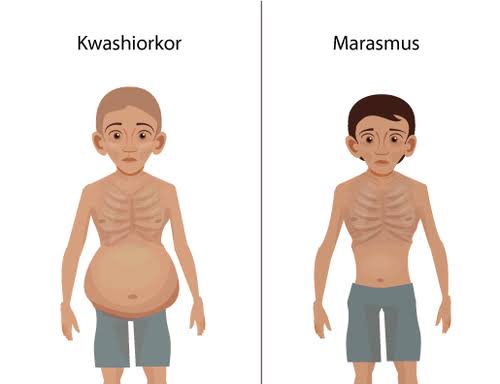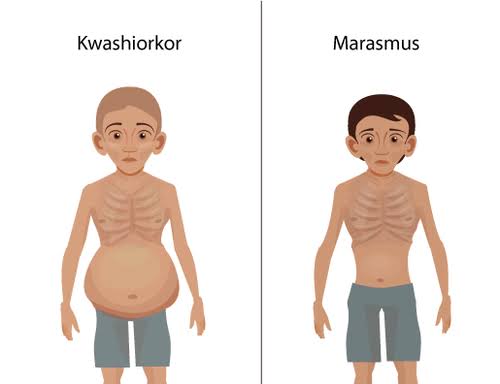What is an example of a Protein Energy Malnutrition Disorders?
Protein Energy Malnutrition (PEM) is a small or abnormal nutritional deficiency that does not meet the nutritional needs of children and adults. Among its main symptoms are weakness, irregular health status of children and increased susceptibility to various diseases.

Types of PEM:
1. Marasmus:
Marasmus is a severe movement disorder that causes weakness and disability. This is due to the fact that a person is not supplied with nutrients for a long time and his body lacks necessary products such as proteins, carbohydrates and fats. Its causes include malnutrition, lack of sleep and physical weakness. Regurgitation is usually seen as a result of malnutrition in children, but it can also be a problem in adults when the appetite is poor in the elderly, sick or elderly.
It is 20 times more common than kwashiorkor.
It usually occurs in children under 2 years of age, but it can also occur in older children.
Etiology: (underlying nutritional causes)
🔸 Marasmus is most often caused by a lack of nutrition or sometimes severely limited food intake. Children's food is caloric, which does not meet the minimum requirements of a rapidly growing child.
🔸 Too diluted milk is given to the child due to ignorance or fear of cost.
🔸 Weaning is not started at all or is done after 4-5 months of age.
🔸 Infections: Diarrhoea, measles, whooping cough and primary tuberculosis can cause malnutrition. Mothers may starve their child after a bout of diarrhea for fear of overfeeding.
🔸Other secondary factors are less frequently responsible for complications.

Clinical results:
🔸The clinical picture consists of growth retardation, significant muscle wasting and loss of subcutaneous fat.
🔸 The face is dry and has no fat pads, the thighs and buttocks are contracted and the skin is loose and hanging in folds.
🔸Abdominal distention due to hypotonic muscles,
🔸The temperature is abnormal.
🔸Tendon reflexes are diminished and in extreme cases plantar reflexes may be absent.
🔸The child hates being examined, but is usually alert and has a good appetite.
🔸Edema is never present.
🔸Skin and hair changes are absent.
Signs Always Present :
🔸 Severe growth failure and weight less than 60% of expected weight.
🔸 Significant muscle wasting and loss of subcutaneous fat.
🔸 The patient is usually alert and has a good appetite.
🔸 The face is shriveled and shriveled like a "little old man" or monkey face. There are practically no hips and the head seems larger in proportion to the body.
Symptoms are rare.
🔸 Lack of blood
🔸 Symptoms of diarrhea and dehydration
🔸 Vitamin deficiency symptoms such as cheilosis, dermatitis and rickets
🔸 It can complicate the clinical picture.
🔸The clinical picture can be complicated by respiratory infections, tuberculosis and measles.
Prevention:
🔸Diagnosis and treatment of early malnutrition
🔸Encourage breastfeeding until the child is 1-2 years old.
🔸Avoid formula until 4-6 months of age.
🔸Introduce semi-solids at 4-6 months of age.
🔸Vaccination and basic care
🔸Prevention of infectious diarrhea, e.g. hand washing
2.Kwashiorkor:
Kwashivarkar is a frailty in the old age of a child that is associated with malnutrition and lack of nutritional energy. It usually occurs in children between the ages of two and five, and causes may include protein-based nutritional deficiencies, inappropriate meal intensity, or nutritional disorders.
Symptoms of kwashiorkor in children include abdominal bloating, loss of appetite, lack of luster, and poor skin and hair growth. Kwashiorkar is usually treated with a high-protein diet, treatment of the infection, and healthy eating habits.

This usually occurs between the ages of 2-5 years. But sooner or later it may happen.
Edema is always present but does not extend into the serous cavity.
The required caloric intake may be a bit low, but protein is significantly lacking.
Signs Always Present :
🔹 Reduces overall swelling
🔹 Failure to thrive (wasting due to edema)
🔹The child is weak and exhausted, but has some fat.
🔹Psychomotor changes such as lethargy and irritability.
Symptoms are usually present:
🔹 Hair changes: fine, straight and thinning hair;
🔹Low protein intake due to malnutrition
🔹 Breeding of marsupials
🔹Malaria
🔹 Loose stools as a result
🔹 Infectious diarrhea
🔹Secondary lactase deficiency

Symptoms are rare:
◾Skin:
▪️ dermatitis of the "scaly color" type and areas covered by either hypopigmentation or hyperpigmentation
▪️ Ulcers or open sores may appear.
▪️ Vitamin deficiency symptoms
◾ Liver:
▪️ The liver is enlarged due to fatty infiltration.
Complication:
▪️Hypothermia
▪️ Hypoglycemia
▪️ Heart failure (shock)
▪️Infection
▪️ Vitamin A deficiency (ulcers and ulcers)
▪️Severe anemia
▪️ Dermatosis
▪️ Watery diarrhea and/or vomiting and dehydration
▪️ Abdominal distension
Recommended Blogs


Mansab Ali


Mansab Ali


Mansab Ali



